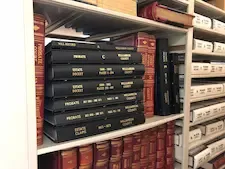... to foster public confidence in genealogy as a respected branch of history by promoting an attainable, uniform standard of competence and ethics among genealogical practitioners, and by publicly recognizing persons who meet that standard ...
Purpose
Incorporated in 1964, BCG is an independent, not-for-profit certifying body that is nationally and internationally recognized. BCG promotes ethics and standards through its certification program and publications. These publications include Genealogy Standards; The BCG Application Guide; OnBoard, its newsletter; and SpringBoard, its blog. BCG also promotes ethics and standards through skillbuilding lectures at national conferences, through seminars, and through webinars.
Certification results from evaluation of work samples in a portfolio submission. For each certification category, BCG requires different materials. Applicants are evaluated on standards for documenting, standards for researching, and standards for writing. Three to four evaluators independently assess each application. Certification says a practitioner has met the rigorous standards for knowledge and competence of the field.
Find a Certified Genealogist®

Take advantage of hiring a Certified Genealogist® by searching in the directory. BCG's associates know the records in their areas of expertise. They are able to research thoroughly, cite properly, analyze and correlate evidence efficiently, deal with conflicting evidence, and write a clear and convincing conclusion.
Become a Certified Genealogist®

Those who hold a Certified Genealogist® credential have demonstrated their competence in research, analysis, kinship determination, and reporting skills. Using the resources here to learn about working to standards and experience may lead to a desire to validate this competence by acquiring the CG® credential. The process is explained.
-
BCG News
BCG approved an interpretation of existing requirements in The BCG Application Guide for the use of artificial intelligence (AI) in a new CG® application portfolio. Read more here.
-
BCG Board
At its semi-annual meeting held on 13 October 2024, the Trustees of the Board for Certification of Genealogists® (BCG) elected officers for the coming year.• President: David Ouimette• Vice President: Angela McGhie• Secretary: Gary Ball-Kilbourne• Member at Large: Karen Stanbary• Member at Large: Scott Wilds -
New Associates
Congratulations to new associates Kristina Gow Clever of Eufaula, AL; Sally D. Hamblen of Lynnfield, MA; Becky L. Stephens of Forney, Texas; Michael Sainsbury of Saskatoon, Saskatchewan; and Theodore Georgas, IL.
-
Associate News
Congratulations to Tom Jones, Karen Stanbary, Shannon Green, Patti Hobbs, Paul Graham, and Mary Roddy for being awarded the Certified Genetic GenealogistSM credential. Congratulations to Shannon Green for being awarded the Certified Genealogist LecturerSM credential.
-
Associate News
Bridget M. Sunderlin of Timonium, Maryland; Kathleen W. Hinckley of Westminster, CO; Robbie Johnson of Sedro Woolley, WA; and Mauri Stotts Pratt of Edmund, OK successfully renewed their credentials.
-

Diane Boumenot
-

Denise Cross
-

Michelle Goodrum
-

Angela Harris
-

Eva Holmes
-

Sharon Hoyt
-

Annette Lyttle
-

Nicole LaRue
-

Judy Russell
-

Craig Scott
-

Ann Staley
-

Karen Stanbary
Upcoming BCG Webinars
- January 21, 2025 – The Everleigh Sisters: A Case Study in Conflict Resolution
- February 18, 2025 — Applying Research Standards to the Census
- March 18, 2025 — The Influence of Free and Cheap Land on Migration
- April 15, 2025 — “A Matrimonial Advertiser:” Tracing the Treacherous Trail of an Early 20th-Century Romance Scammer
- May 20, 2025 — From Despair to Cargoes of Hope: WWII's Displaced Persons

